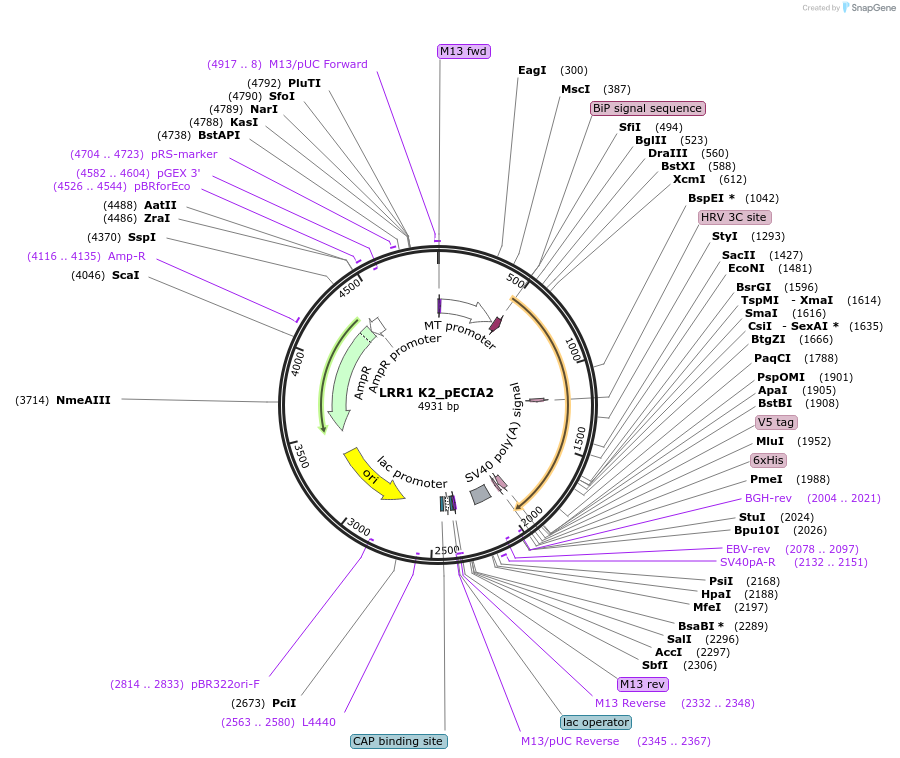LRR1 K2_pECIA2
(Plasmid
#115001)
-
PurposeBait vector LRR1 K2_pECIA2 should be used with prey vector LRR1 K2_pECIA14.
-
Depositing Lab
-
Sequence Information
Ordering
| Item | Catalog # | Description | Quantity | Price (USD) | |
|---|---|---|---|---|---|
| Plasmid | 115001 | Standard format: Plasmid sent in bacteria as agar stab | 1 | $89 | |
Backbone
-
Vector backbonepECIA2
-
Backbone manufacturerChris Garcia (Addgene plasmid # 47032)
-
Vector typeInsect Expression
Growth in Bacteria
-
Bacterial Resistance(s)Ampicillin, 100 μg/mL
-
Growth Temperature37°C
-
Growth Strain(s)DH5alpha
-
Copy numberHigh Copy
Gene/Insert
-
Gene/Insert nameAT5G16590
-
SpeciesA. thaliana (mustard weed)
-
Entrez GeneAT5G16590 (a.k.a. AT5G16590, LRR1, Leucine rich repeat protein 1, MTG13.3, MTG13_3)
- Promoter Metallothionein (Copper-Inducible)
-
Tag
/ Fusion Protein
- Fc, V5 and hexahistidine tags (C terminal on backbone)
Cloning Information
- Cloning method Ligation Independent Cloning
Terms and Licenses
-
Academic/Nonprofit Terms
-
Industry Terms
- Not Available to Industry
Trademarks:
- Zeocin® is an InvivoGen trademark.
Depositor Comments
Plasmid for secreted expression in Drosophila cell culture by induction via CuSO4. Insert is an extracellular domain of indicated LRR-RK, C-terminally tagged with Fc, V5 and hexahistidine tags. Insert Protein Sequence: SDLEADRRALIALRDGVHGRPLLWNLTAPPCTWGGVQCESGRVTALRLPGVGLSGPLPIAIGNLTKLETLSFRFNALNGPLPPDFANLTLLRYLYLQGNAFSGEIPSFLFTLPNIIRINLAQNNFLGRIPDNVNSATRLATLYLQDNQLTGPIPEIKIKLQQFNVSSNQLNGSIPDPLSGMPKTAFLGNLLCGKPLDACPVNGTGNGTVTPGGKGKSDKLS
These plasmids were created by your colleagues. Please acknowledge the Principal Investigator, cite the article in which the plasmids were described, and include Addgene in the Materials and Methods of your future publications.
-
For your Materials & Methods section:
LRR1 K2_pECIA2 was a gift from Youssef Belkhadir (Addgene plasmid # 115001 ; http://n2t.net/addgene:115001 ; RRID:Addgene_115001) -
For your References section:
An extracellular network of Arabidopsis leucine-rich repeat receptor kinases. Smakowska-Luzan E, Mott GA, Parys K, Stegmann M, Howton TC, Layeghifard M, Neuhold J, Lehner A, Kong J, Grunwald K, Weinberger N, Satbhai SB, Mayer D, Busch W, Madalinski M, Stolt-Bergner P, Provart NJ, Mukhtar MS, Zipfel C, Desveaux D, Guttman DS, Belkhadir Y. Nature. 2018 Jan 18;553(7688):342-346. doi: 10.1038/nature25184. Epub 2018 Jan 10. 10.1038/nature25184 PubMed 29320478



